How to Dry Basil in a Dehydrator
If you want to know how to dry basil in a dehydrator, this article is for you. This technique is great when you have a lot of basil to dry. If you have smaller amounts, you might want to consider drying basil in the microwave or hanging your basil to dry. Of course, you could also freeze it or make pesto with it.
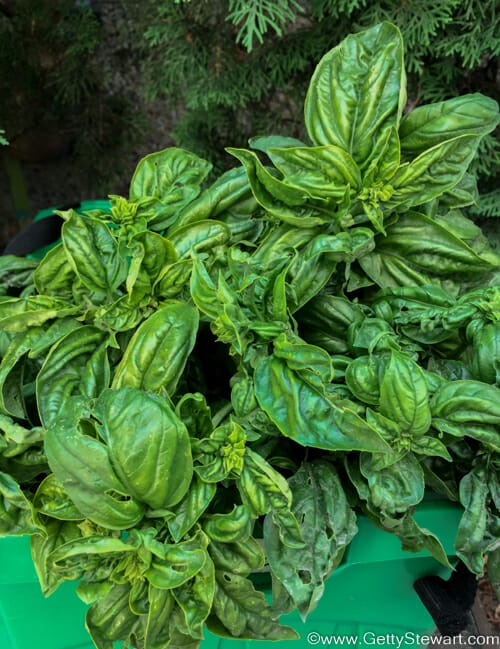
Read more: Dry Basil in Microwave, How to Cut Fresh Basil, How to Store Fresh Basil.
I like using the dehydrator to dry basil, because it’s easier, quicker and more consistent than hanging to dry. While I freeze some basil, I like having dried basil on hand for more flexibility in where and how I use basil, since I don’t always want the water or oil that comes with freezing basil.
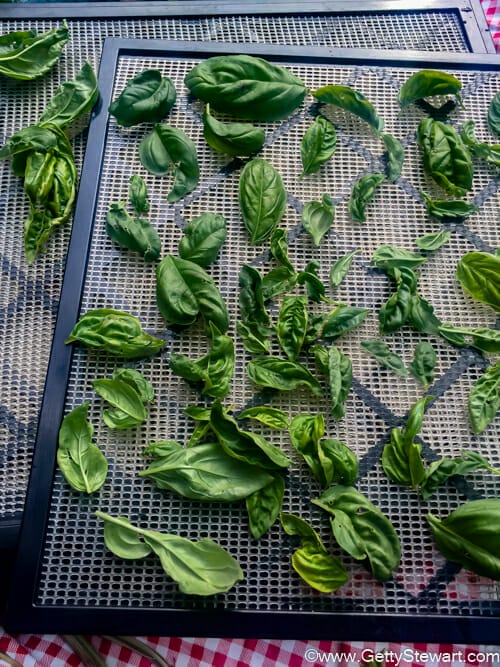
No matter which method you use, here are some important things to remember about drying basil…
- basil is easily bruised – handle gently every step of the way
- water drops lead to brown spots – remove surface moisture from leaves before drying
- basil leaves have a high oil content – this means they will take quite a bit of time to dry and require plenty of air circulation
- basil leaves may turn rusty colored when dried – be prepared for discoloration
Some discoloration of basil is normal and expected. However if you’re basil turns black or has black spots, that might be a sign of mold or mildew – this is not good! If you suspect mold, toss out your basil. It will have lost its flavor and more importantly, you do not want to ingest mold. To prevent mold, make sure your basil dries relatively quickly and has plenty of air circulation. A dehydrator helps by speeding up the drying process. If you are hanging basil to dry, make sure the bundles are small so air can get at every leaf.
With those key points in mind, here’s how to dehydrate basil leaves.
How to Dehydrate Basil Leaves
How to Dehydrate Basil Leaves
Ingredients
- Fresh Basil Leaves
Instructions
- Wash – Wash your basil. I bet you’ll be surprised at how much dirt is on those leaves!
- Remove Surface Water – Dry your freshly washed basil leaves. I spread them out on towels, pat them gently and then just let them lay out for an hour. It was such a lovely day with a gentle warm breeze, that I did this outside this year.
- Arrange on Trays – Gently remove the leaves from the stems and lay them out on the drying screens so there is space between them for air to circulate. By removing the stems, everything dries more evenly and quickly.
- Dehydrate Until Crumbly – Place dehydrating trays in dehydrator and set at herb setting (just about the lowest setting there is) 35°C or 95°F. If humidity levels in your house and outside are low, start checking at 6 hours, but don’t be surprised if basil takes 12 to 24 hours to dry completely. You will know basil is dry enough when the leaves are crisp and crumbly. If they wrinkle in your hands but don’t crumble into bits, they’re not dry enough!
- Store Whole Leaves in Jar – Remove from tray and place in well sealed glass jars. You’ll get longer lasting flavor from dried basil by keeping leaves whole. In other words, DO NOT crumble until ready to use. Basil will start to lose flavor after about 6 months but I use until next year’s basil crop is ready. By that time, I usually end up using more dried basil than a recipe calls for, but I’m still getting basil flavor.
Video
How to Use Dried Basil
I use dried basil in just about any tomato dish you can think of. I usually add it to recipes fairly early in the cooking process so it can rehydrate and release all its flavor. In fact, when I’m making spaghetti sauce, I add the basil just before I add the tomato sauce so I can fry the herbs with the onions a little to release their aroma. Man does the house ever smell good at that point!
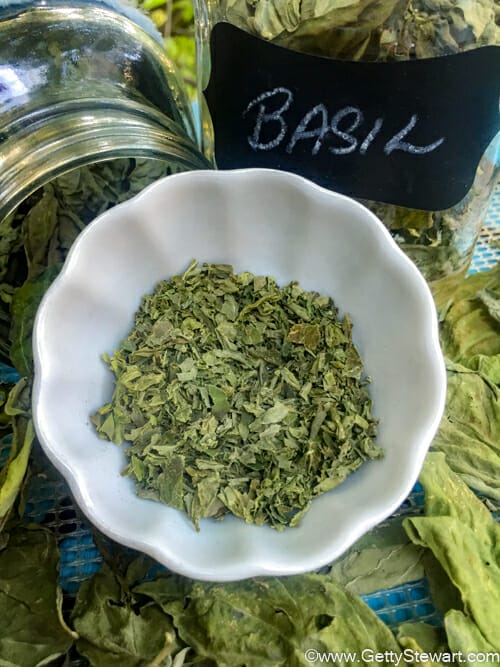
I also use dried basil in my homemade seasoning blends like this Italian Herb Seasoning. Do you have favorite recipes that you use dried basil in? Please let me know so I can try it!

Be confident growing and using herbs.
With NO ads, and all the best tips & recipes in one convenient place! From Garden to Table: Everyday Cooking with Herbs.
65 recipes & preserves + practical tips…
- how to grow herbs
- step-by-step harvesting and preserving instructions
- tantalizing tea and beverage recipes
- mouth watering appetizers, salads, mains, and desserts
- solve all your herb FAQs
Available in ebook and paperback formats.
Select, store and serve seasonal food for everyday cooking with Getty. Getty is a food educator and Professional Home Economist, who loves sharing tips and recipes following the seasons from her Canadian kitchen. Sign up to get seasonal tips and recipes delivered to your inbox. Learn more about Getty or check out her books and pdf guides.


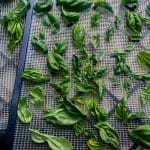
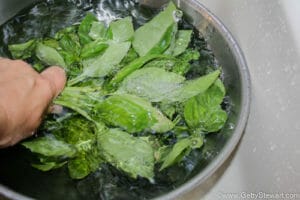
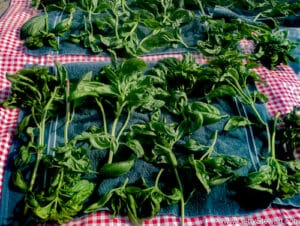
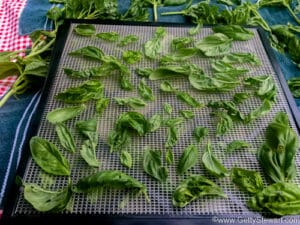

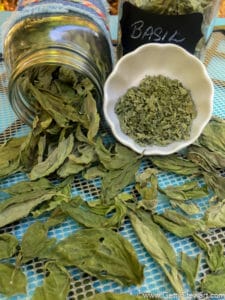

Some of your dried basil looks to have dark spots as does mine. They aren’t really black but a dark green. Is this just bruising or should I be concerned about mold?
Yes, some of my basil does turn quite dark. Sometimes it’s hard to tell if it is mold or just oxidizing while drying. My methods for determining are very subjective based on look, feel and everything I know about the drying process and conditions. If I am confident that I properly removed all surface moisture prior to drying, the drying conditions were absolutely dry (not humid or raining through the garage roof while it was hanging to air dry), the basil feels crispy and dry, and the coloration doesn’t look like a mold growth, then I assume it is just oxidation. If in doubt, I throw it out – I really don’t want my family to consume mold. It won’t make you sick right away, but the toxins build up over time – no thank you.
This is not a very helpful process or answer, is it?! Yes basil will turn dark. Yes it is prone to mold. My best recommendation is if in doubt, toss it out.
Good luck,
Getty
Thanks for the simple instructions you give us. I am new at dehydrating. In my country, Greece, our grandmothers dehydrated in the sun or at their warehouses by hanging whatever they wanted to dehydrate from strings. Then they kept the dehydrated food in pillowcases or in ceramic containers. Inside they always put garlic and daphne leaves or oregano sticks το avoid insects.
Could you please tell me how much do dehydrated foods last in jars without oxygen absorbers? I am interested in long term storage. Is there a solution less expensive? Thanks for your time. 🙂
Hi Yianna,
Thank you for sharing your grandmothers’ methods. I can only imagine what that must have looked like. Sounds serene and lovely, but a lot of work!
I have never used oxygen absorbers and my goal is not extended long term storage. My goal is for food to last for one maybe two years. I have not had any issues keeping my food that long in glass jars without anything else. As for less expensive options, I wonder if you had a home food sealer so you can use plastic bags that you can vacuum seal? Not sure if that would work for you.
Good luck and thanks for stopping by.
Getty